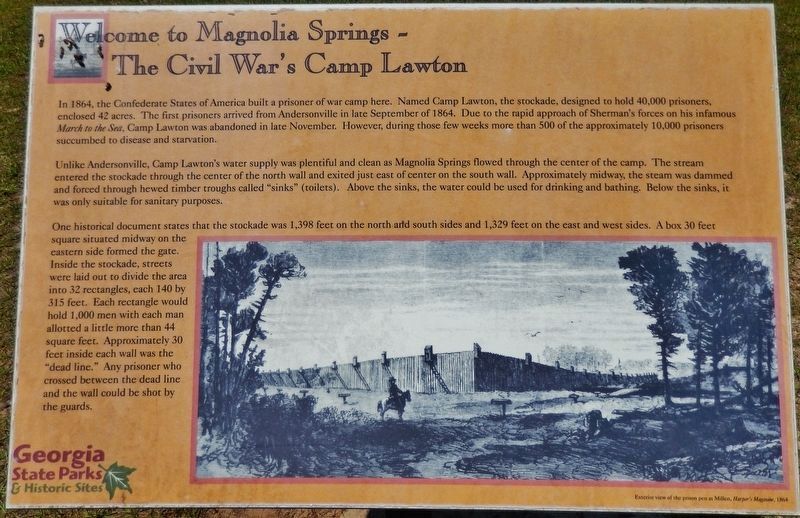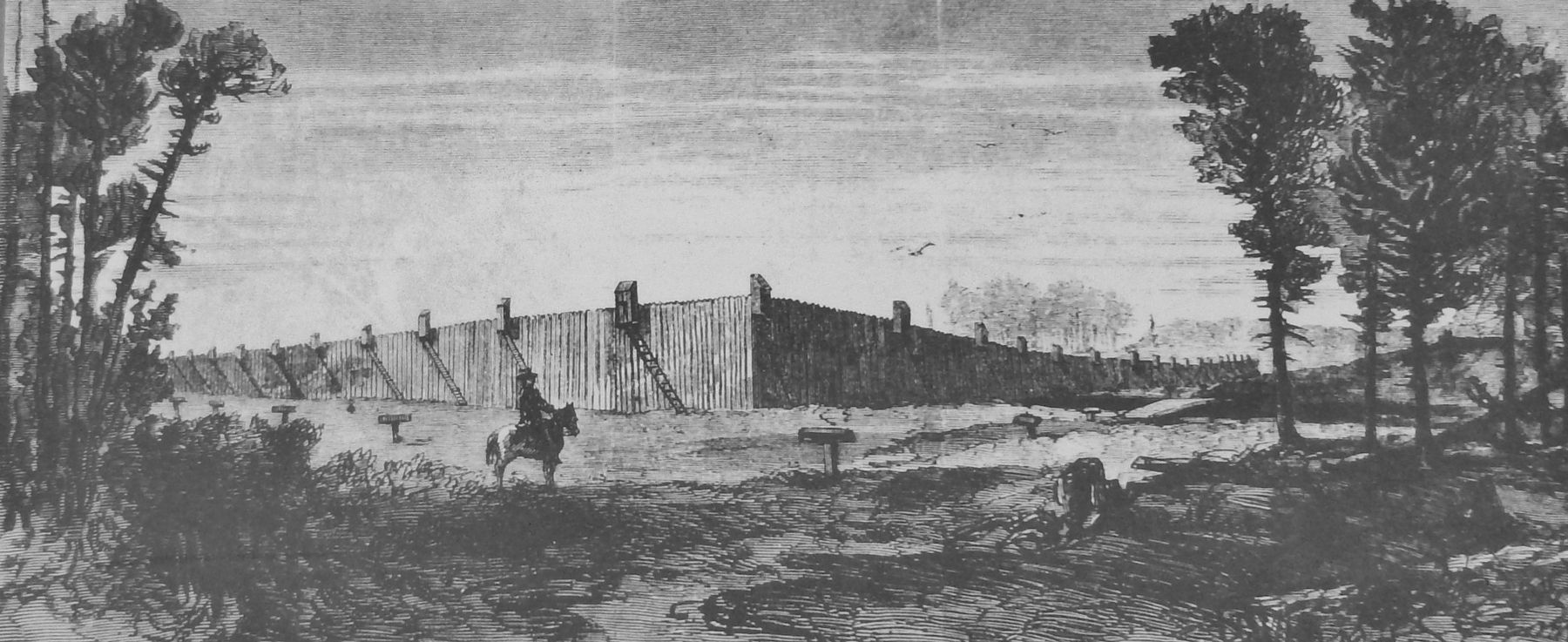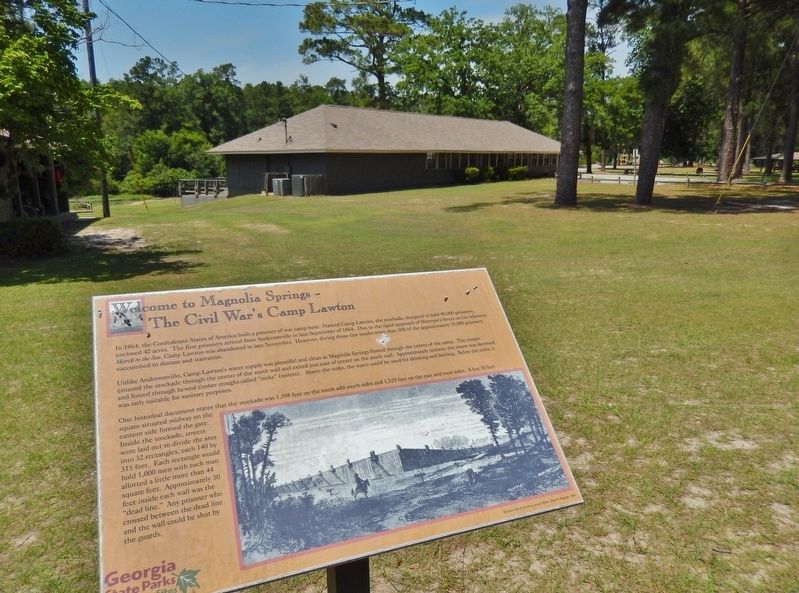Millen in Jenkins County, Georgia — The American South (South Atlantic)
Welcome to Magnolia Springs – The Civil War’s Camp Lawton
Inscription.
In 1864, the Confederate States of America built a prisoner of war camp here. Named Camp Lawton, the stockade, designed to hold 40,000 prisoners, enclosed 42 acres. The first prisoners arrived from Andersonville in late September of 1864. Due to the rapid approach of Sherman's forces on his infamous March to the Sea, Camp Lawton was abandoned in late November. However, during those few weeks more than 500 of the approximately 10,000 prisoners succumbed to disease and starvation.
Unlike Andersonville, Camp Lawton's water supply was plentiful and clean as Magnolia Springs flowed through the center of the camp. The stream entered the stockade through the center of the north wall and exited just east of center on the south wall. Approximately midway, the stream was dammed and forced through hewed timber troughs called "sinks" (toilets). Above the sinks, the water could be used for drinking and bathing. Below the sinks, it was only suitable for sanitary purposes.
One historical document states that the stockade was 1,398 feet on the north and south sides and 1,329 feet on the east and west sides. A box 30 feet square situated midway on the eastern side formed the gate. Inside the stockade, streets were laid out to divide the area into 32 rectangles, each 140 by 315 feet. Each rectangle would hold 1,000 men with each man allotted a little more than 44 square feet. Approximately 30 feet inside each wall was the "dead line." Any prisoner who crossed between the dead line and the wall could be shot by the guards.
Erected by Georgia State Parks & Historic Sites.
Topics. This historical marker is listed in these topic lists: Forts and Castles • War, US Civil. A significant historical year for this entry is 1864.
Location. 32° 52.534′ N, 81° 57.489′ W. Marker is in Millen, Georgia, in Jenkins County. Marker can be reached from Magnolia Springs Road, 0.4 miles east of U.S. 25, on the left when traveling east. Marker is located in Magnolia Springs State Park, on the north side of the main parking lot, in front of the Visitor Center. Touch for map. Marker is at or near this postal address: 1053 Magnolia Springs Road, Millen GA 30442, United States of America. Touch for directions.
Other nearby markers. At least 8 other markers are within 5 miles of this marker, measured as the crow flies. Camp Lawton (within shouting distance of this marker); The Civil War's Camp Lawton (about 300 feet away, measured in a direct line); Old Buckhead Church (approx. 2˝ miles away); Big Buckhead Church (approx. 4.2 miles away); Cavalry Action at Buckhead Church (approx. 4.2 miles away); Battle of Buck Head Creek (approx. 4.2 miles away); Carswell Grove Baptist Church
(approx. 4.2 miles away); Sherman at Millen (approx. 5 miles away). Touch for a list and map of all markers in Millen.
Related markers. Click here for a list of markers that are related to this marker. Civil War Camp Lawton
Also see . . .
1. Camp Lawton Prisoner of War Camp. Camp Lawton, a huge prisoner of war camp occupying 40 acres and designed to hold 40,000 men, was built in September, 1864 to relieve congestion at Camp Sumter at Andersonville and to remove the possibility of Gen. W.T. Sherman's army freeing prisoners there. Built by a force of 300 prisoners and 500 slaves, the camp was a log stockade, with guard towers on the walls, and a ditch dug within the walls for a deadline. (Submitted on February 23, 2018, by Cosmos Mariner of Cape Canaveral, Florida.)
2. Magnolia Springs State Park. During the Civil War, this site was called Camp Lawton and served as “the world’s largest prison.” Today, little remains of the prison stockade; however, the earthen breastworks which guarded it may still be seen. During 2010, Georgia Southern University archeology teams uncovered the stockade wall and numerous personal articles from soldiers. Their discovery has been heralded as one of the most significant
finds in recent history. Artifacts are currently on display at the university and at the Camp Lawton museum located at Magnolia Springs State Park. (Submitted on March 12, 2019, by Cosmos Mariner of Cape Canaveral, Florida.)
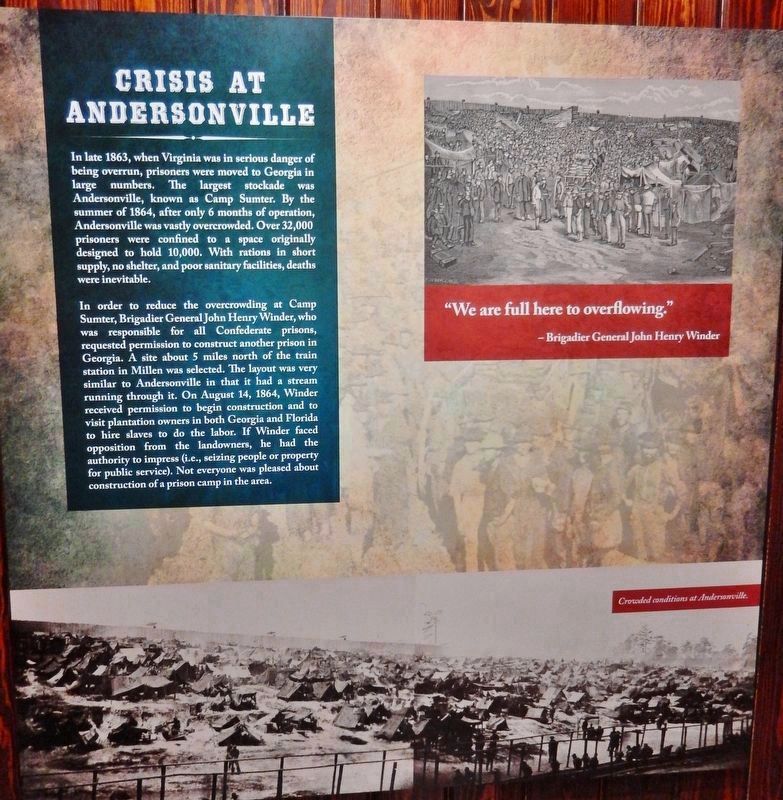
Photographed By Cosmos Mariner, May 11, 2017
4. Crisis At Andersonville (interpretive plaque inside Camp Lawton Museum)
In late 1863, when Virginia was in serious danger of being overrun, prisoners were moved to Georgia in large numbers. The largest stockade was Andersonville, known as Camp Sumter. By the summer of 1864, after only 6 months of operation, Andersonville was vastly overcrowded. Over 32,000 prisoners were confined to a space originally designed to hold 10,000. With rations in short supply, no shelter, and poor sanitary facilities, deaths were inevitable.
In order to reduce the overcrowding at Camp Sumter, Brigadier General John Henry Winder, who was responsible for all Confederate prisons, requested permission to construct another prison in Georgia. A site about 5 miles north of the train station in Millen was selected. The layout was very similar to Andersonville in that it had a stream running through it. On August 14, 1864, Winder received permission to begin construction and to visit plantation owners in both Georgia and Florida to hire slaves to do the labor. If Winder faced opposition from the landowners, he had the authority to impress (i.e., seizing people or property for public service). Not everyone was pleased about construction of a prison camp in the area.
In order to reduce the overcrowding at Camp Sumter, Brigadier General John Henry Winder, who was responsible for all Confederate prisons, requested permission to construct another prison in Georgia. A site about 5 miles north of the train station in Millen was selected. The layout was very similar to Andersonville in that it had a stream running through it. On August 14, 1864, Winder received permission to begin construction and to visit plantation owners in both Georgia and Florida to hire slaves to do the labor. If Winder faced opposition from the landowners, he had the authority to impress (i.e., seizing people or property for public service). Not everyone was pleased about construction of a prison camp in the area.
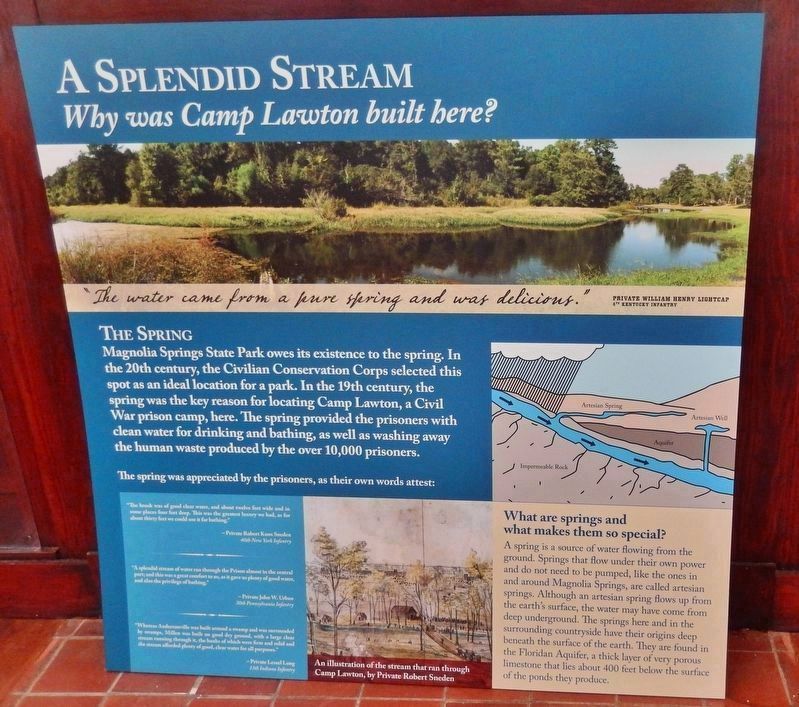
Photographed By Cosmos Mariner, May 11, 2017
5. Why was Camp Lawton Built Here? (interpretive plaque inside Camp Lawton Museum)
Magnolia Springs State Park owes its existence to the spring. In the 20th century, the Civilian Conservation Corps selected this spot as an ideal location for a park. In the 19th century, the spring was the key reason for locating Camp Lawton, a Civil War prison camp, here. The spring provided the prisoners with clean water for drinking and bathing, as well as washing away the human waste produced by the over 10,000 prisoners.
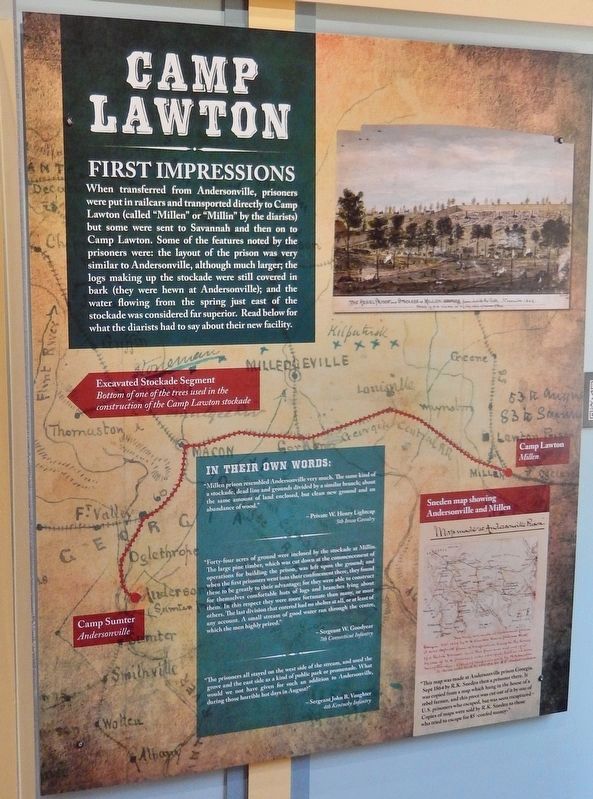
Photographed By Cosmos Mariner, May 11, 2017
6. Camp Lawton First Impressions (interpretive plaque inside Camp Lawton Museum)
When transferred from Andersonville, prisoners were put in railcars and transported directly to Camp Lawton but some were sent to Savannah and then on to Camp Lawton. Some of the features noted by the prisoners were: the layout of the prison was very similar to Andersonville, although much larger, the logs making up the stockade were still covered in bark (they were hewn at Andersonville); and the water flowing from the spring just east of the stockade was considered far superior.
Credits. This page was last revised on March 13, 2019. It was originally submitted on February 23, 2018, by Cosmos Mariner of Cape Canaveral, Florida. This page has been viewed 578 times since then and 45 times this year. Photos: 1, 2, 3, 4, 5, 6. submitted on February 23, 2018, by Cosmos Mariner of Cape Canaveral, Florida. • Bernard Fisher was the editor who published this page.
